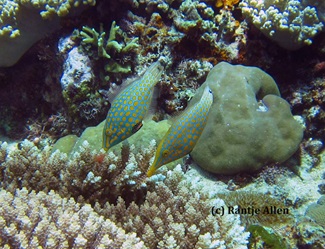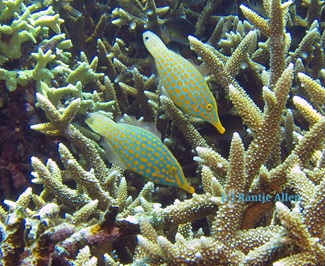Loading content - please wait...
Longnose filefish bob away
Longnose filefish are rare inhabitants of Gorontalo’s shallow reefs. But one lucky diver shot a video before they bobbed away.
By Many Names
The scientific name for this beautiful fish is Oxymonacanthus longirostris. That name means “long nose.” However, the English name is sometimes Orange-spotted filefish. Other times, it is Harlequin filefish. These names reflect the fish’s colorful body pattern.
Distinctive Beauty
The Longnose filefish has unmistakable coloring. Its pale blue body sports about seven irregular rows of bright orange spots. These spots are darkly rimmed. Yellow starting from the forehead colors the length of the fish’s long face. The skin surrounding the eyes is orange with flecks of pale blue. At end of its tail is a black blotch. Under the fish’s belly is a small, irregular black patch covered with tiny white dots. This dark patch is often unnoticed.
Also unnoticed is the fish’s file. All filefish have a sharp spine on the top of the head. Most of the time, this spine is folded tightly flush with the skull. Sometimes, however, the Longnose filefish will flex its head spine, and careful divers can observe it briefly.
Video of Longnose Filefish
Divers rarely see Longnose filefish in Gorontalo. These fish prefer shallow waters here of less than two meters. So, looking for them during a safety stop is a good idea. However, spotting them is unlikely since they are rare here. They also move and turn quickly to remain out of sight. These filesfish swim in irregular ways, bobbing and twisting. They swim in pairs or small groups.
Enjoy the brief video shot by one of our guests several years ago.
Form and Function
The prominent nose of the Longnose filefish serves an important function. As seen in the video, these fish prefer to inhabit areas of Acropora. Branching Acropora are common in shallow reefs in Gorontalo. Notice the fleshy lips at the end of the fish’s nose. Longnose filefish feed on Acropora polyps, using its pointed mouth to suck the polyp into this mouth. Scientists call this way of feeding cephalopharyngeal teeth protrusion. That means the fish quickly extends its jaws. With the vacuum created, the fish can suck the coral polyp from its home.
Researchers also say that this fish absorbs chemicals from the coral polyps to mask the fish’s scent. This helps protect the fish from predators. Its irregular swimming patterns also aid it. Other researchers state that Longnose filefish also eat tiny crustaceans.
Adult Longnose filefish measure about 12 to 19 centimeters. However, those found in Gorontalo are about half that size. They are occasionally found throughout Indo-Pacific waters in shallow, ocean-facing reefs.
For your chance to search for this beautiful fish in Gorontalo, make your dive reservations directly with Miguel’s Diving.








Sorry, comments are closed for this post.